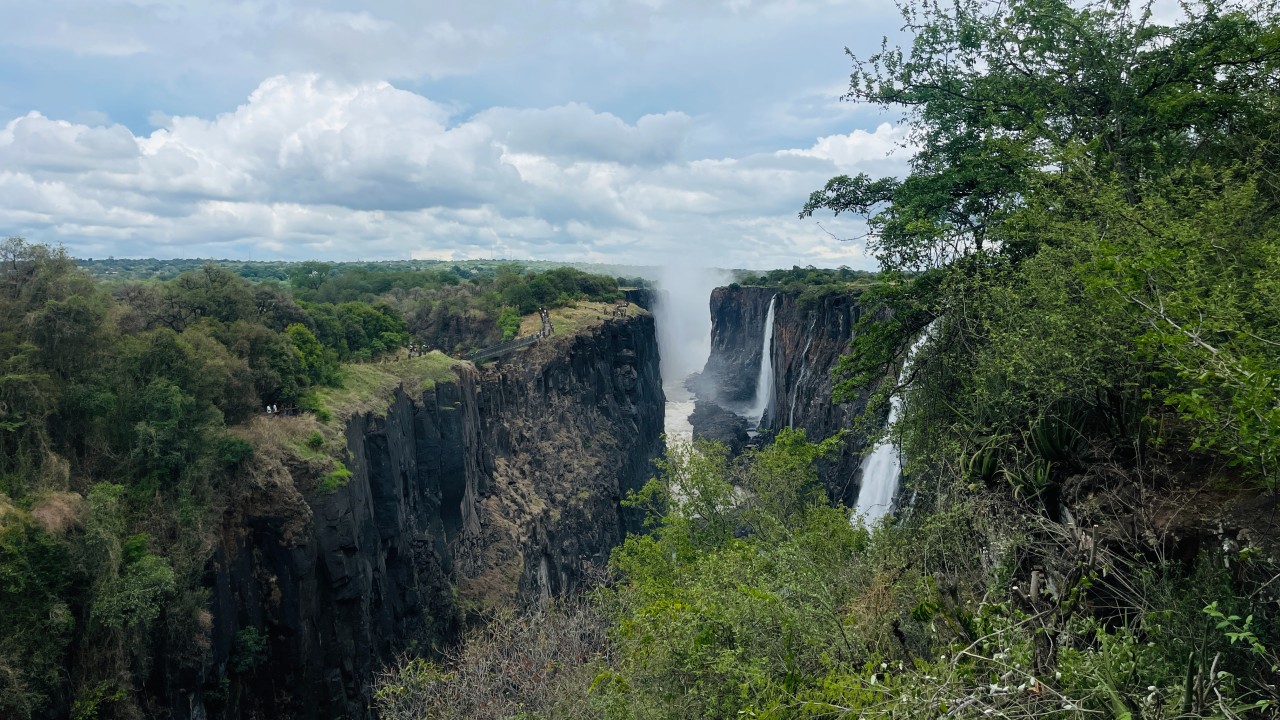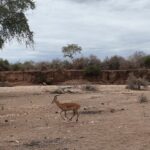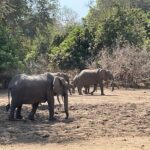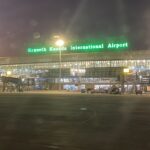Zambia is one of Africa’s hidden gems, located in the southern region of the continent and known for its unforgettable safari experiences, pristine landscapes, and rich cultural heritage. This region of Africa is renowned for its diverse ecosystems and vibrant traditions. From the roaring Victoria Falls to the untamed wilderness of South Luangwa and Lower Zambezi National Parks, the country is a haven for eco-conscious travelers. But beyond its beauty, Zambia stands as a model for how sustainable tourism can help protect endangered wildlife and uplift local communities. In this article, we explore how tourism in Zambia goes hand in hand with conservation and community development—and how your travel choices can make a real difference.
What is Sustainable Tourism?
Sustainable tourism is all about making travel a force for good—benefiting the environment, wildlife, and local communities while providing enriching experiences for visitors. Around the world, many countries are working together to develop and implement sustainability standards in tourism. These standards enable destinations and practitioners to adopt best practices, ensuring tourism minimizes negative impacts and maximizes positive contributions to local economies, cultural preservation, and conservation efforts.
In Zambia, sustainable tourism means supporting lodges and operators that protect national parks, reduce carbon footprints, and invest in local people. Whether it’s hiring local guides, conserving endangered species, or promoting traditional crafts, sustainable travel plays a key role in preserving Zambia’s natural heritage for generations to come.
Zambia’s Rich Wildlife and Natural Ecosystems
Zambia is home to some of Africa’s most unspoiled and diverse ecosystems, making it a top destination for nature lovers and safari enthusiasts. The country boasts 20 national parks and over 30 game management areas, each offering unique landscapes and wildlife encounters. Iconic parks like South Luangwa, located in the renowned Luangwa Valley, Lower Zambezi, Kafue, and Liuwa Plains are teeming with wildlife, including elephants, lions, leopards, buffalo, hippos, crocodiles, and hundreds of bird species.
South Luangwa is especially known for its walking safaris, while the Lower Zambezi offers stunning canoe trips along the Zambezi River, surrounded by animals in their natural habitat. These protected areas not only draw eco-tourists from around the world but also serve as critical sanctuaries for Zambia’s biodiversity. Sustainable tourism helps ensure these parks remain intact, preserving delicate ecosystems while supporting the livelihoods of those who depend on them.
Zambia’s climate is defined by distinct seasons: the dry season, which includes the cool dry season from May to August with lower temperatures and clear skies, followed by the hot dry season from September to October when temperatures rise sharply and conditions become hottest. The rainy season, from November to April, brings heavy rainfall that transforms the landscape and impacts wildlife movement and viewing opportunities. The southwest region, along with the Luangwa Valley, experiences some of the highest mean daily maximum temperatures during the hot dry season. Lake Kariba, a major reservoir, plays a significant role in Zambia’s ecosystems, supporting both wildlife and local communities.
Conservation Success Stories in Zambia
Zambia has made significant strides in wildlife conservation, thanks to collaborative efforts between the government, NGOs, local communities, and responsible tourism operators. One of the country’s most inspiring successes is the reintroduction of black rhinos in the northern part of Zambia, specifically North Luangwa National Park, where a dedicated team of rangers and conservationists has worked tirelessly to protect this critically endangered species. This area, once part of Northern Rhodesia before Zambia gained independence in 1964, has a rich history of conservation challenges and achievements.
Anti-poaching units, often supported by tourism revenue, have also helped stabilize elephant populations in key parks like South Luangwa and Kafue. These teams use modern tools such as drones, GPS tracking, and community intelligence to monitor and respond to threats. By preventing illegal hunting, these efforts help stop the destruction of ecosystems and wildlife populations.
Another success is the Conservation South Luangwa (CSL) initiative, which trains local people as wildlife rangers and promotes coexistence between humans and animals. These programs not only protect Zambia’s rich biodiversity but also create jobs and instill a sense of pride and ownership in local communities. These conservation efforts are part of a broader history of wildlife protection in Zambia, reflecting the country’s ongoing commitment to preserving its natural heritage.
Key Conservation Partnerships Driving Change in Zambia
Zambia’s conservation landscape is bolstered by several strategic partnerships that unite governmental bodies, NGOs, and local communities to protect biodiversity and promote sustainable development. The country lies in south-central Africa, bordered by Tanzania to the northeast, the Democratic Republic of the Congo to the north, and Zimbabwe to the south, sharing vital ecosystems and conservation challenges with these neighbors. As a nation that transitioned from colonial rule to an independent democratic republic, Zambia’s political evolution has shaped its conservation policies and fostered cross-border collaborations, particularly with Tanzania, Congo, and Zimbabwe. Here are some notable collaborations:
- IFAW & Conservation Lower Zambezi (CLZ)
The International Fund for Animal Welfare (IFAW) and Conservation Lower Zambezi (CLZ) have partnered to enhance conservation efforts in the Lower Zambezi National Park and surrounding Game Management Areas. This collaboration focuses on wildlife protection, biodiversity conservation, combating wildlife crime, and supporting community engagement initiatives.
Historically, the Lower Zambezi region played a significant role as part of trade routes that connected the interior of Africa to the Indian Ocean.
- Kafue Flats Restoration Partnership
The Kafue Flats Restoration Partnership is a collaborative effort involving the International Crane Foundation, Zambia’s Department of National Parks and Wildlife, WWF Zambia, and the Endangered Wildlife Trust. This initiative aims to restore and manage the Kafue Flats’ wetlands, which are vital for species like the endangered Wattled Crane and the endemic Kafue Lechwe. The partnership also recognizes the crucial role of forests in maintaining the health and biodiversity of the Kafue Flats ecosystem, as forests support climate stability and provide essential habitats for a wide range of species. The partnership emphasizes community involvement, sustainable resource use, and ecosystem resilience in the face of climate change.
- North Luangwa Conservation Programme (NLCP)
Established in 1986, the NLCP is a joint venture between the Frankfurt Zoological Society and Zambia’s Department of National Parks and Wildlife. The program focuses on conserving the North Luangwa ecosystem through anti-poaching efforts, wildlife reintroductions (notably black rhinos), community development, and sustainable land-use planning. It also supports local livelihoods through initiatives like beekeeping and conservation farming. Additionally, the program helps preserve traditional forms of cultural expression, such as ceremonies, arts, and other practices important to the heritage of local communities.
- African Parks in Kafue National Park and Beyond
In 2021, the Zambian government entered a 20-year agreement with African Parks to manage Kafue National Park, Zambia’s largest and oldest national park. African Parks has since implemented measures to improve infrastructure, bolster law enforcement, and engage local communities in conservation efforts. As part of their approach, African Parks works to ensure that local communities retain access to land and resources within and around the parks, supporting equitable access while promoting conservation. The organization also manages Liuwa Plain National Park and Bangweulu Wetlands, focusing on ecological restoration and sustainable tourism development.
National Parks: Gateways to Conservation and Adventure
Zambia’s national parks are the beating heart of the country’s conservation efforts and a magnet for adventure seekers from around the world. Covering more than 30% of Zambia’s land area, these protected regions are not only vital for safeguarding biodiversity but also serve as living classrooms where visitors can immerse themselves in Africa’s natural environment. From the lush river valleys of South Luangwa to the vast plains of Kafue and the dramatic landscapes of Lower Zambezi, each park offers a unique window into the country’s rich wildlife and ecosystems.
Managed by the Zambian government in close partnership with local communities, these national parks are a testament to the power of collaboration in protecting natural resources. Visitors can embark on thrilling game drives, guided walking safaris, and canoeing adventures, all while witnessing elephants, lions, giraffes, and countless other species in their natural habitats. These experiences not only create unforgettable memories but also generate essential income for surrounding communities, supporting education, healthcare, and sustainable resource management.
By choosing to explore Zambia’s national parks, travelers play a direct role in conservation and community empowerment. Every visit helps fund the protection of wildlife, the preservation of the environment, and the growth of the local economy—ensuring that these incredible landscapes remain a source of pride and prosperity for generations to come.
Community-Based Tourism: Empowering Local People
Sustainable tourism in Zambia isn’t just about wildlife—it’s also about people. Community-based tourism puts local residents at the heart of the travel experience, creating opportunities for them to earn a living while sharing their culture and traditions with visitors. Community-based tourism initiatives are found in various parts of Zambia, reflecting the country’s cultural and regional diversity.
Across Zambia, you’ll find villages offering cultural tours, homestays, traditional cooking classes, and local craft markets. These experiences allow travelers to connect meaningfully with Zambian communities while directly contributing to their income. Local guides, for example, provide unique insights into the land and wildlife, making safaris and walking tours more authentic.
Projects like the Luangwa Safari Association’s Community Fund and Time + Tide Foundation support education, healthcare, and skills training in rural areas—all funded through tourism. By choosing community-based experiences, travelers help strengthen the link between conservation and local development, making tourism a tool for long-term empowerment. These projects also help improve the quality of life for local residents, supporting the well-being of families and communities.
Regenerative Tourism: Going Beyond Sustainability
Regenerative tourism is redefining the way we think about travel in Zambia. Unlike traditional sustainable tourism, which focuses on minimizing harm, regenerative tourism aims to create a positive impact—restoring and enhancing the natural environment, uplifting local communities, and strengthening the economy. This forward-thinking approach recognizes that tourism can be a powerful force for conservation and community well-being, not just a source of income.
In Zambia, regenerative tourism means supporting initiatives that go beyond simply preserving resources. It’s about actively improving the land, investing in community projects, and celebrating cultural heritage. Visitors are invited to engage with local people, learn about their traditions, and participate in activities that leave the destination better than they found it. Many lodges and tour operators are embracing regenerative practices, from rewilding landscapes and supporting conservation research to funding education and health programs in rural communities.
By choosing regenerative tourism experiences, travelers help to ensure that their presence brings lasting benefits—supporting conservation, promoting sustainable development, and enhancing the well-being of Zambia’s people. It’s a chance to be part of a movement that not only protects what makes Zambia special but also helps it thrive for the future.
Eco-Tourism Activities in Zambia
Zambia is a paradise for eco-tourism enthusiasts, offering a diverse array of activities that allow visitors to connect deeply with the country’s natural environment and vibrant wildlife. Whether you’re tracking the Big Five on a game drive, exploring the bush on a walking safari, or gliding silently down the Zambezi River in a canoe, every adventure is designed to be low-impact and sustainable.
The country’s national parks and game management areas are teeming with species—from majestic elephants and elusive leopards to rare birds and endemic plants. Local guides, with their intimate knowledge of the land and its stories, lead these experiences, ensuring that tourism supports both conservation and the well-being of their communities. Birdwatching, photographic safaris, and even night drives offer unique perspectives on Zambia’s biodiversity.
For those looking to make an even greater difference, many eco-tourism operators invite guests to participate in hands-on conservation efforts. Activities like tree planting, wildlife monitoring, and community development projects not only enrich your travel experience but also directly support the protection of Zambia’s natural environment and the prosperity of local communities. By choosing eco-tourism, you become an active partner in Zambia’s journey toward sustainable development and conservation.
Eco-Lodges and Responsible Travel Options
In Zambia, many safari lodges and camps are leading the way in sustainable hospitality, making the country one of Africa’s emerging sustainable tourism destinations. These eco-lodges are built with minimal environmental impact, use renewable energy sources like solar power, and follow strict waste reduction and recycling practices. Over time, they have developed advanced sustainability practices that set a benchmark for responsible travel. Staying at these properties allows travelers to enjoy comfort and luxury while reducing their ecological footprint.
Lodges such as Chiawa Camp in Lower Zambezi, Mfuwe Lodge in South Luangwa, and Shumba Camp in Kafue are known for their commitment to conservation and community support. They hire locally, source food and materials from nearby villages, and fund conservation programs directly from guest stays.
When planning a trip to Zambia, choosing responsible tour operators and lodges ensures your travel dollars support the environment and the people who protect it. Look for certifications or affiliations with organizations like Travelife, EcoTourism Zambia, or Fair Trade Tourism to help guide your choices.
Tourism and Climate Change: Challenges and Solutions
Tourism is both a blessing and a challenge in the context of climate change. While it brings vital income to Zambia and supports conservation, it also contributes to greenhouse gas emissions through travel, accommodation, and activities. Recognizing this, Zambia’s tourism industry is taking proactive steps to reduce its environmental footprint and protect the country’s natural environment for future generations.
Across Zambia, eco-lodges and tour operators are adopting sustainable practices—using renewable energy, minimizing waste, and reducing pollution. Many are investing in solar power, water conservation, and eco-friendly building materials, setting new global standards for responsible tourism. Visitors can play their part by choosing these green options, offsetting their carbon emissions, and supporting businesses that prioritize the well-being of the environment and local communities.
Governments, tourism operators, and local communities are working together to find innovative solutions, from reforestation projects to education campaigns about climate resilience. By making conscious choices and supporting sustainable tourism, travelers help to mitigate the negative impacts of climate change, promote conservation, and ensure that Zambia’s natural wonders remain accessible and vibrant for years to come.
The Role of Zambia’s Tourism Industry in Conservation
Zambia’s tourism industry is a cornerstone of the country’s conservation success, especially within its renowned national parks and game management areas. By attracting visitors from around the world, the industry generates crucial revenue that supports the protection of wildlife, the preservation of habitats, and the sustainable management of natural resources.
Tourism provides meaningful employment and income for local communities, creating incentives to protect the land and its species rather than exploit them. This economic support enables communities to invest in education, healthcare, and infrastructure, improving overall well-being and fostering a culture of stewardship. The industry also funds vital conservation initiatives, from anti-poaching patrols to habitat restoration and the safeguarding of endangered species.
By working hand-in-hand with governments, conservation organizations, and local communities, Zambia’s tourism sector is committed to minimizing negative impacts on the environment while maximizing positive outcomes for people and nature. Through responsible tourism practices, the industry not only supports the country’s economy but also ensures that Zambia’s extraordinary biodiversity and natural beauty are protected for future generations to enjoy.
Challenges Facing Sustainable Tourism in Zambia
While Zambia has made impressive progress in sustainable tourism, several challenges still hinder its full potential. Limited funding remains a major obstacle. Many conservation and community programs rely heavily on tourism revenue, which can fluctuate with global travel trends or political and economic changes. The ongoing search for innovative solutions to funding and conservation challenges is crucial to ensure long-term sustainability.
Human-wildlife conflict is another pressing issue. In rural areas near national parks, animals like elephants or lions may stray into villages, threatening crops and livestock. Without effective mitigation strategies, these conflicts can undermine local support for conservation.
Additionally, climate change is altering ecosystems, affecting wildlife migration patterns, water availability, and park accessibility. Some areas are also vulnerable to over-tourism, especially during peak seasons, which puts pressure on infrastructure and natural resources.
Addressing these challenges requires a united effort from governments, conservation groups, tour operators, and travelers. Open discussions among stakeholders are essential to share ideas and develop practical solutions. The aim of sustainable tourism efforts in Zambia is to balance economic growth with the preservation of natural and cultural resources. With continued education, funding, and innovation, Zambia can grow its tourism industry without compromising its environmental and cultural integrity.
How You Can Travel Responsibly in Zambia
As a traveler, your choices matter. By embracing responsible travel habits, you can help protect Zambia’s wildlife and uplift local communities. Here are a few ways to make your trip more sustainable:
- Choose eco-friendly lodges and operators: Look for those that support conservation, use renewable energy, and employ local staff.
- Support local businesses: Buy handmade crafts, eat at locally-owned restaurants, and book tours with community-based guides.
- Respect wildlife and nature: Keep a safe distance from animals, never feed them, and avoid littering in protected areas.
- Travel light and green: Bring reusable water bottles and bags, and minimize plastic use.
- Offset your carbon footprint: Consider supporting tree-planting or clean energy projects that help balance emissions from your travel.
Every responsible decision—big or small—adds up. When you travel consciously in Zambia, you’re not just having an unforgettable adventure, you’re also contributing to a more sustainable and inclusive future.
Conclusion
Zambia is a shining example of how tourism, when done responsibly, can become a powerful force for good. As a Christian nation, Zambia’s cultural landscape is shaped by its values and traditions, which influence its approach to hospitality and community engagement. From preserving iconic wildlife in South Luangwa to empowering communities through village tourism and conservation jobs, sustainable tourism is helping protect the country’s natural heritage while improving lives.
With the support of dedicated conservation partnerships and eco-conscious travelers, Zambia is building a future where wildlife thrives, communities flourish, and travelers leave a positive impact. Located in the south central part of Africa, Zambia serves as a crossroads between Central, Southern, and East Africa, enriching its regional identity and diversity. As you plan your next adventure, consider how your choices—where you stay, how you travel, and who you support—can contribute to a more sustainable and inclusive Zambia.
Travel with purpose. Travel responsibly. And let Zambia’s wild beauty inspire you to make a difference. The historical influence of Indian communities and trade has also contributed to Zambia’s rich cultural tapestry, further enhancing its unique character.






